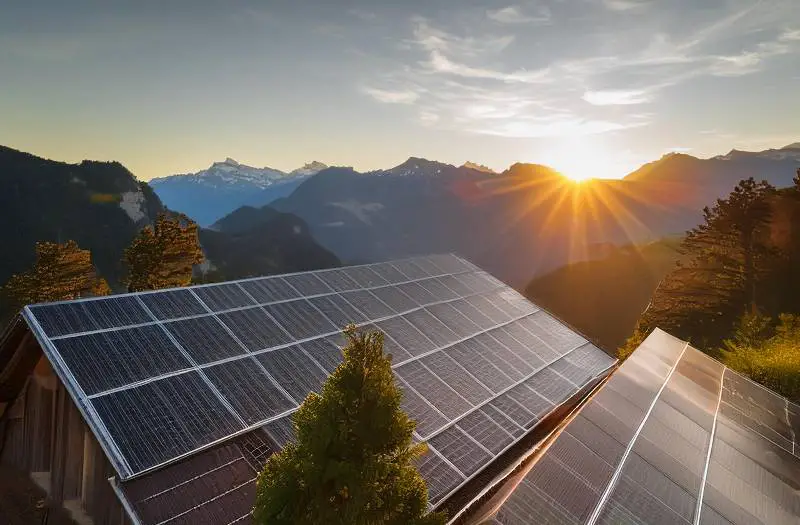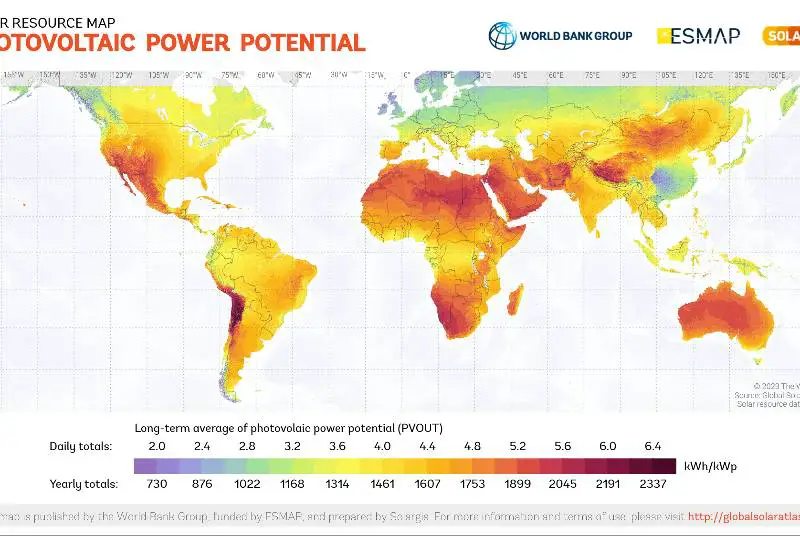What Is a Solar Panel Tilt Angle?
Solar panel tilt angle refers to the angle at which your solar panels are set relative to the ground, optimizing the amount of sunlight they can capture.
The tilt angle of your solar panels should ideally match the angle of the sun’s rays for maximum sunlight absorption.
This angle varies depending on your geographic location, the time of year, and the specific daily trajectory of the sun across the sky.
Factors Affecting Solar Panel Tilt Angle
1. Latitude
The most significant factor in determining the optimal tilt angle for your solar panels is your latitude.
Generally, the simplest rule of thumb is to set the panel tilt angle equal to the latitude of the location to maximize the annual energy production.
This angle positions the panels to face the sun at its highest point in the sky, which is usually at solar noon.
2. Seasonal Variations
The sun’s path changes with the seasons, affecting how much sunlight falls on a tilted surface. \
In winter, the sun is lower in the sky, and tilting panels steeper (closer to vertical) can capture more sunlight.
During summer, the sun is higher, so a flatter (closer to horizontal) tilt works better.
Adjusting the tilt angle seasonally can optimize solar capture and increase overall energy production.
3. Weather Patterns
Local weather conditions can also influence the optimal tilt angle.
For instance, areas with high snowfall might benefit from steeper angles in winter to help shed snow that could block sunlight.
In contrast, regions with a lot of overcast days might adjust angles to maximize exposure during peak sunlight hours when the sky is clear.
4. Roof Design
The design of your roof can significantly constrain or influence your tilt angle options.
If installing panels on a flat roof, you have full control over the tilt angle.
However, panels on sloped roofs must often conform to the roof’s angle, which may not be ideal. In such cases, special mounting systems can adjust the angle, though this may add to the installation cost.
5. Shadowing
Shadows from trees, buildings, and other structures can impact the effectiveness of a chosen tilt angle.
Even if the angle is perfect for sun exposure, shadows during key times of day can significantly reduce energy production.
A careful assessment of shadow patterns over the day and year is essential when deciding the tilt angle to avoid these obstructions as much as possible.
6. System Configuration
The specific configuration of your solar system can influence the ideal tilt angle.
For larger installations, or where panels are arranged in rows, the tilt might be adjusted to prevent panels from shading each other as the sun moves.
This is especially important in densely packed installations or where ground-mounted systems are being used.
How to Calculate My Solar Panel Azimuth Angle?
1. Determine Your Location’s Latitude and Longitude
Since the azimuth angle is like the secret handshake for getting your solar panels to play nice with the sun, you gotta start by figuring out where you stand—literally.
This means nailing down your exact spot on the globe.
It’s all about those latitude and longitude coordinates, the GPS pins that tell you where you are in the world.
Finding these numbers can be a breeze if you’re comfortable with technology.
Your smartphone is more than ready to spill the beans on your location.
Just pop open your maps app, and there you are—your phone becomes your personal navigator, giving you precise coordinates.
But if you’re more of a desktop adventurer, the internet’s got your back.
A quick trip to Google Maps, a click here, a tap there, and voila, your latitude and longitude reveal themselves.
And for those who prefer the human touch or a bit of detective work, your local government might just hold the key.
A visit to their website or a friendly phone call can lead you to those all-important digits that mark your spot on the map.
I live in Los Angeles, California, where my exact coordinates are approximately 34.0549° N latitude and -118.2426° W longitude.
We’ll be using this figure as our starting point to dive into the calculation of the solar panel azimuth angle.
2. Calculate the Declination Angle (δ)
The sun’s declination angle is the angle between the solar position and the celestial equator, measured along the circle that includes the sun and the celestial poles.
Now, because the Earth is a bit tilted as it goes around the sun, the sun’s position changes throughout the year.
It can go as high as +23.5 degrees during the summer when it’s beaming down on us full blast, or dip down to -23.5 degrees in the winter.
To pinpoint the declination angle on any day of the year, we use this formula:
δ = 23.45 × sin ( 360 / 365 × (d+10))
Here, δ represents the declination angle, and d stands for the day of the year, counting from January 1st.
Let’s put this into action with an example.
Say we want to find the sun’s declination angle for April 1st.
April 1st is the 91st day of the year (because January has 31 days, February has 28 days, and March has 31 days, so 31 + 28 + 31 = 90, plus one for April 1st makes 91).
Plugging that into our formula:
δ = 23.45 × sin ( 360 / 365 × (91+10)) = 23.12°
This figure tells us the sun is north of the celestial equator, which makes sense as we’re moving into spring in the Northern Hemisphere.
The higher declination angle means the sun is climbing higher in the sky, leading to longer days and shorter nights—a key insight for anyone looking to optimize solar panel efficiency.
3. Calculate the Hour Angle (ℎ)
The hour angle is a way of measuring time, based on the position of the sun in the sky.
It tells us how far the sun is from its highest point in the sky at noon.
The hour angle changes by 15 degrees each hour, reflecting the Earth’s rotation.
At solar noon, when the sun is at its highest point, the hour angle is 0 degrees.
Before noon, the hour angle is negative (since the sun is moving towards its highest point), and after noon, it’s positive (as the sun moves away from its highest point).
To calculate the hour angle for any given time, you can use the formula:
ℎ = 15 × (LST − 12)
where LST stands for Local Solar Time, which adjusts your standard time to account for the equation of time and your longitude relative to your time zone’s central meridian.
Let’s say we want to find the hour angle for 10 AM in Los Angeles.
Assuming we’ve adjusted our time for the equation of time and longitude, we’d simply plug our values into the formula:
ℎ = 15 × (10 − 12) = −30
This tells us that at 10 AM, the sun is 30 degrees away from being at its highest point in the sky, indicating it’s before solar noon.
4. Calculate the Solar Elevation Angle (ɑ)
Now that we’ve got our hour angle figured out, the next step is to calculate the solar elevation angle (α).
This angle tells us how high the sun is in the sky, from the horizon up towards the zenith (the highest point directly above).
To calculate the solar elevation angle, we use a bit more complex formula that considers the sun’s declination angle, our latitude, and the hour angle.
The formula looks something like this:
α = arcsin (sin(δ)×sin(ϕ)+cos(δ)×cos(ϕ)×cos(h))
In this formula:
- α is the solar elevation angle we want to find.
- δ is the declination angle of the sun.
- ϕ is the latitude of the location (for Los Angeles, it’s about 34.0549° N).
- ℎ is the hour angle we calculated before.
Now, we plug those numbers into our formula to find out exactly how high the sun will be in the sky:
α = arcsin (sin(23.12°) × sin (34.0549°) + cos(23.12°) × cos(34.0549°) × cos(−30°)) = 61.61°
This means that at 10 AM on April 1st in Los Angeles, the sun will be approximately 61.61 degrees above the horizon.
5. Calculate the Solar Azimuth Angle (A)
Finally, we’ve arrived at the step where we determine the solar azimuth angle (A), the direction where your solar panels should face to capture the maximum sunlight.
This angle tells us where the sun is on the horizon, measured in degrees from the north.
To calculate the solar azimuth angle, we consider the sun’s elevation angle (α), the declination angle (δ), and our latitude (ϕ).
There’s a general formula, but it changes slightly depending on whether it’s morning or afternoon.
For simplicity, let’s focus on the morning formula since our example involves 10 AM:
A = arccos(cos(ϕ) × cos(α) / sin(δ) − sin(ϕ) × sin(α))
Now, let’s plug these values into our formula to find the solar azimuth angle for Los Angeles at 10 AM on April 1st:
A = arccos(cos(34.0549°) × cos(61.61°) / sin(23.12°) − sin(34.0549°) × sin(61.61°)) = 59.296°
Thus, at 10 AM on April 1st in Los Angeles, the solar panels should be oriented at an azimuth angle of 59.296 degrees from north to capture the maximum amount of sunlight.
FAQs
How Do You Find the Azimuth of a Solar Panel?
You find the azimuth of a solar panel by calculating the angle from true north to where the panel faces, using solar elevation, declination, and your latitude.
What Is the Best Azimuth Angle for Solar Panels?
The best azimuth angle for solar panels is due south in the northern hemisphere and due north in the southern hemisphere.
How Do You Calculate the Angle of Solar Panels?
You calculate the angle of solar panels based on your latitude and the sun’s declination to maximize exposure to direct sunlight.
Wrapping Up
As promised, we’ve covered the steps to calculate the solar panel azimuth angle, from pinpointing your exact location to understanding the sun’s declination and elevation angles.
However, I’ve still some advice: always consider the seasonal changes in the sun’s path.
Adjusting your solar panels a couple of times a year to account for these shifts can further enhance your system’s efficiency.
This approach ensures you’re always capturing the maximum amount of sunlight, no matter the time of year.
Join our solar microdosing newsletter and get bite-sized, easy-to-understand insights into the world of solar energy.
From how solar panels work to building your own DIY solar system, we’ve got you covered.





